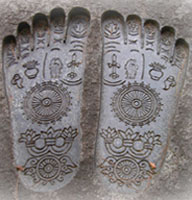What is Reflexology?
Reflexology is the application
of the right amount of pressure to specific points and areas on the feet,
hands, or ears. Reflexologists believe that these areas and reflex
points correspond to different body organs and systems, and that
pressing them has a beneficial effect on the organs and person's general
health.
Reflexology is not used to diagnose or cure health disorders,
millions of people around the world use it to complement other
treatments like anxiety, asthma, cancer treatment, cardiovascular
issues, diabetes, headaches, kidney function, PMS, and sinusitis.
In reflexology points and areas on the feet, hands, and ears
correspond to specific organs, bones and body systems. Practitioners
access these points on the feet and hands (bottom, sides, and top) and
the ear (both inside as far as the finger can reach and outside) to
affect organs and systems throughout the entire body.
Maps of
reflex points have been passed between practitioners. There is not agreement among all reflexologists on all of the
points.There is a general agreement on major reflex points.
Also there is some scientific documentation of linkages between the skin and internal
organs.
To represent how the body systems correspond
to one another there are reflexology maps.
Here
are a few I found on line. Now I have looked at a lot of maps and all
are alike in many ways. I just picked one for each Ear, Foot and Hand.
Each side represents a vertical
half of the body. So on that side of the body there will be points on
the hand, ear or foot that are connected to that side of the body's
organs, valves, ect.
Example: On the left foot it corresponds to the left side of the body and all organs, valves, etc. found there.
Same for the
right foot it corresponds to the right side of the body and all organs
found there.
So because the liver is on the right side of the body the point will be on the right hand, ear or foot.
A
reflexologist may perform a general, integrated session, or they may focus
on specific problem areas on the feet, hands or ears.
For example, if
time is limited and the person really needs to relax, the reflexologist
may choose just to work on the ears.
Whatever the approach is the
reflexologist attempts to release congestion or stress in the nervous
system and put balance back into the body's energy.
I
had read some were that you would put pressure with your thumb and
first finger by pressing the spot that affects you for 5 seconds and
release for 3 seconds. You will repeat this for 2-3 minutes for 5-10
days until you get relief. I have tried this on my hands for pain in my
lower back and it does help.I also used it to help with the pain from my
PCOS and I really think it made a difference because when the cysts
bust the pain is so bad it will linger sometimes for a good few hours. I
will press the ovaries area and it helps so much.
Where does reflexology come from?
Because reflexology is an
ancient practice, its origin and history is difficult to track. However,
reflexology is thought to have been passed down through an oral
tradition, and possibly first recorded as a pictograph on the Egyptian
tomb of Ankhamor in 2330 BC along with other medical procedures.
Reflexology
symbols are also thought to be recorded on the feet of statues of
Buddha in India and later China. The Chinese classic, the Yellow
Emperor's Classic of Internal Medicine, which was written around 1,000
BC, has a chapter on "Examining Foot Method" and is the beginning of
discussions in print about the connection of life force and points and
areas on the feet.
It is believed that Marco Polo translated a
Chinese massage book into Italian in the 1300s, thus introducing
reflexology and massage to Europe. In 1582, a book on an integral
element of reflexology called zone therapy was first published in Europe
by Dr. Adamus and Dr. A'tatis.
In the United States, William H.
Fitzgerald, MD, who is frequently referred to as the father of
reflexology, wrote in 1917 about ten vertical zones that extended the
length of the body. He found that the application of pressure to a zone
that corresponded to the location of an injury could serve as relief of
pain during minor surgeries.
Dr. Fitzgerald's work was expanded by
Dr. Shelby Riley, who developed a map of horizontal zones going across
the body and a detailed map of reflex points on the feet and hands. He
also suggested pressure points on the outer ear.
Eunice Ingham, a
physiotherapist who worked for Dr. Riley, is another prominent figure
in the development of reflexology. In her research with zone therapy's
pressure points, she found the feet to be the most sensitive and
responsive. She developed the foot maps still in use today and
introduced reflexology practices to the non-medical community in the
1930s. Ms. Ingham also designed one of the most commonly used
reflexology charts, which has since been refined by her nephew, Dwight
Byers, at the International Reflexology Institute.
In 1957, Dr.
Paul Nogier recorded a reflex map of points on the outer ear. His work
has been expanded by Oleson and Flocco and is now being taught as part
of an integrated approach to hand, ear and foot reflexology.
Reference:
http://takingcharge.csh.umn.edu/explore-healing-practices/reflexology
Here are a few sights that explain more of the how to do reflexologyhttp://www.wikihow.com/Do-Reflexology
Here is some great videos on how to do the reflexology
http://www.ehow.com/video_4397505_reflexology-differences-between-right-left.html?wa_vlsrc=continuous&pid=1&wa_vrid=565977d2-ad0f-40c8-b889-5d69cbdcb497&cp=1








Thanks for sharing. Great post very Informative, also checkout Modern Institute of Reflexologic
ReplyDeleteMagnificent website. Everyone should read. For more amazing info you can find it from this link Reflexology Means
ReplyDelete